顺序表动态实现
一、步骤
1、定义一个结构体
2、创建一个顺序表
3、创建一个数据元素
4、初始化顺序表
5、在表中插入元素
6、打印顺序表中全部的元素。
7、表尾插入元素
8、删除第n个元素
9、删除末尾元素
10、获取第n个元素的值
11、获取元素值所在的位置
12、销毁顺序表
二、代码
1、定义一个结构体
#include <stdio.h>
#include <string.h>
#include <stdlib.h>
#define INITSIZE 10 // 顺序表的初始长度。
#define EXTSIZE 5 // 每次扩展元素的个数。
typedef int ElemType; // 自定义顺序表的数据元素为整数。
typedef struct
{
ElemType *data; // 存储顺序表中元素的首地址。
unsigned int maxsize; // 顺序表元素的最大长度。
unsigned int length; // 顺序表中元素的个数。
}SeqList,*PSeqList;
int main()
{
return 0;
}
2、创建一个顺序表
int main()
{
SeqList LL; // 创建顺序表
return 0;
}
3、创建一个数据元素
int main()
{
SeqList LL; // 创建顺序表
ElemType ee; // 创建一个数据元素。
return 0;
}
4、初始化顺序表
void InitList(PSeqList LL);
void ClearList(PSeqList LL);
int main()
{
SeqList LL; // 创建顺序表
ElemType ee; // 创建一个数据元素。
InitList(&LL); // 初始化顺序表。
return 0;
}
void InitList(PSeqList LL)
{
LL->data=(ElemType *)malloc(sizeof(ElemType)*INITSIZE);
LL->maxsize=INITSIZE;
ClearList(LL); // 清空顺序表。
}
// 清空顺序表。
void ClearList(PSeqList LL)
{
if (LL == NULL) return; // 检查空指针。
LL->length=0;
memset(LL->data,0,sizeof(ElemType)*LL->maxsize);
}
5、在表中插入元素
int InsertList(PSeqList LL, unsigned int ii, ElemType *ee);
int ExtList(PSeqList LL);
int main()
{
SeqList LL; // 创建顺序表
ElemType ee; // 创建一个数据元素。
InitList(&LL); // 初始化顺序表。
printf("在表中插入元素(1、2、3、4、5、6、7、8、9、10)。\n");
ee=1; InsertList(&LL, 1, &ee);
ee=2; InsertList(&LL, 1, &ee);
ee=3; InsertList(&LL, 1, &ee);
ee=4; InsertList(&LL, 1, &ee);
ee=5; InsertList(&LL, 1, &ee);
ee=6; InsertList(&LL, 1, &ee);
ee=7; InsertList(&LL, 1, &ee);
ee=8; InsertList(&LL, 1, &ee);
ee=9; InsertList(&LL, 1, &ee);
ee=10; InsertList(&LL, 1, &ee);
return 0;
}
// 扩展顺序表的内存空间,返回值:0-失败;1-成功。
int ExtList(PSeqList LL)
{
// 分配新的内存空间。
ElemType *newdata=(ElemType *)malloc(sizeof(ElemType)*(LL->maxsize+EXTSIZE));
// 如果分配失败,返回0。
if (newdata == NULL) return 0;
memset(newdata,0,sizeof(ElemType)*(LL->maxsize+EXTSIZE));
// 把顺序表中原来的内容复制到新分配的内存空间中。
memcpy(newdata,LL->data,sizeof(ElemType)*LL->maxsize);
// 释放原来的内存空间。
free(LL->data);
// 把顺序表数据元素的指针指向新分配的内存空间的地址。
LL->data=newdata;
// 重置顺序表的maxsize变量。
LL->maxsize=LL->maxsize+EXTSIZE;
return 1;
}
// 在顺序表LL的第ii个位置插入元素ee,返回值:0-失败;1-成功。
int InsertList(PSeqList LL, unsigned int ii, ElemType *ee)
{
if ( (LL == NULL) || (ee == NULL) ) return 0; // 检查空指针。
if (LL->length >= LL->maxsize)
{
if (ExtList(LL) == 0) { printf("护展顺序表失败。\n"); return 0; }
}
// 判断插入位置是否合法
if ( (ii < 1) || (ii > LL->length+1) )
{
printf("插入位置(%d)不合法,应该在(%d-%d)之间。\n",ii,1,LL->length+1); return 0;
}
// 注意,元素后移只能用循环,不能用以下注释掉的方法,当元素是结构体时,以下方法不稳定。
// if ( ii < LL->length+1)
// memcpy(LL->data+ii,LL->data+ii-1,(LL->length-ii+1)*sizeof(ElemType));
// 把ii和ii之后的元素后移。
int kk;
for (kk=LL->length;kk>=ii;kk--)
{
memcpy(LL->data+kk,LL->data+kk-1,sizeof(ElemType)); // 采用memcpy是为了支持ee为结构体的情况。
// memcpy(&LL->data[kk],&LL->data[kk-1],sizeof(ElemType)); // 也可以采用数组的形式。
}
memcpy(LL->data+ii-1,ee,sizeof(ElemType)); // 采用memcpy是为了支持ee为结构体的情况。
LL->length++; // 表的长度加1。
return 1;
}
6、打印顺序表中全部的元素。
void PrintList(PSeqList LL);
int main()
{
SeqList LL; // 创建顺序表
ElemType ee; // 创建一个数据元素。
InitList(&LL); // 初始化顺序表。
printf("在表中插入元素(1、2、3、4、5、6、7、8、9、10)。\n");
ee=1; InsertList(&LL, 1, &ee);
ee=2; InsertList(&LL, 1, &ee);
ee=3; InsertList(&LL, 1, &ee);
ee=4; InsertList(&LL, 1, &ee);
ee=5; InsertList(&LL, 1, &ee);
ee=6; InsertList(&LL, 1, &ee);
ee=7; InsertList(&LL, 1, &ee);
ee=8; InsertList(&LL, 1, &ee);
ee=9; InsertList(&LL, 1, &ee);
ee=10; InsertList(&LL, 1, &ee);
PrintList(&LL);
return 0;
}
// 打印顺序表中全部的元素。
void PrintList(PSeqList LL)
{
if (LL == NULL) return; // 检查空指针。
if (LL->length == 0) { printf("表为空。\n"); return; }
int kk;
for (kk = 0; kk < LL->length; kk++)
{
printf("%-3d", *(LL->data+kk)); // 如果元素ee为结构体,这行代码要修改。
}
printf("\n");
}

7、表尾插入元素
// 在顺序表LL的尾结点插入元素ee,返回值:0-失败;1-成功。
int PushBack(PSeqList LL, ElemType *ee);
int main()
{
SeqList LL; // 创建顺序表
ElemType ee; // 创建一个数据元素。
InitList(&LL); // 初始化顺序表。
printf("在表中插入元素(1、2、3、4、5、6、7、8、9、10)。\n");
ee=1; InsertList(&LL, 1, &ee);
ee=2; InsertList(&LL, 1, &ee);
ee=3; InsertList(&LL, 1, &ee);
ee=4; InsertList(&LL, 1, &ee);
ee=5; InsertList(&LL, 1, &ee);
ee=6; InsertList(&LL, 1, &ee);
ee=7; InsertList(&LL, 1, &ee);
ee=8; InsertList(&LL, 1, &ee);
ee=9; InsertList(&LL, 1, &ee);
ee=10; InsertList(&LL, 1, &ee);
PrintList(&LL);
ee=12; PushBack(&LL, &ee);
PrintList(&LL);
return 0;
}
// 在顺序表LL的尾结点插入元素ee,返回值:0-失败;1-成功。
int PushBack(PSeqList LL, ElemType *ee)
{
return InsertList(LL,LL->length+1,ee);
}
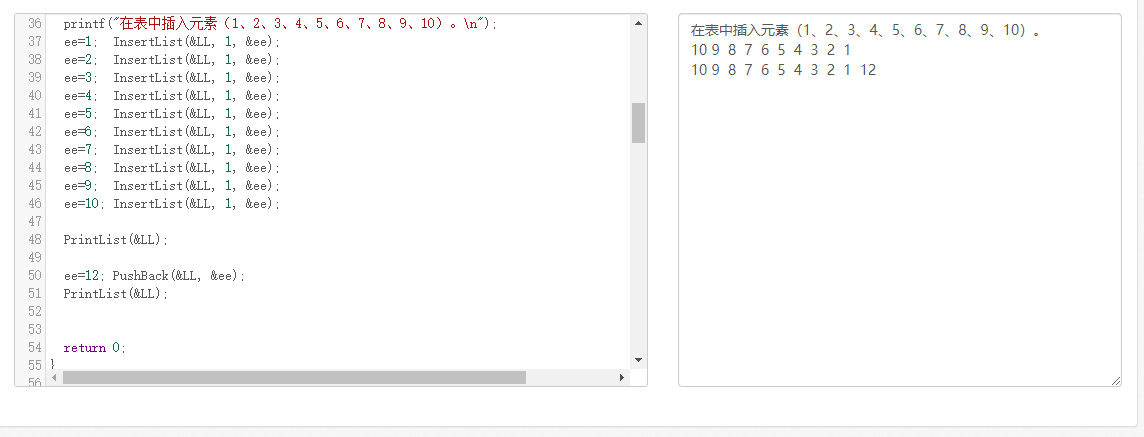
8、"删除表中第n个元素
// 删除顺序表LL中的第ii个元素,返回值:0-位置ii不合法;1-成功。
int DeleteElem(PSeqList LL, unsigned int ii);
int main()
{
SeqList LL; // 创建顺序表
ElemType ee; // 创建一个数据元素。
InitList(&LL); // 初始化顺序表。
printf("在表中插入元素(1、2、3、4、5、6、7、8、9、10)。\n");
ee=1; InsertList(&LL, 1, &ee);
ee=2; InsertList(&LL, 1, &ee);
ee=3; InsertList(&LL, 1, &ee);
ee=4; InsertList(&LL, 1, &ee);
ee=5; InsertList(&LL, 1, &ee);
ee=6; InsertList(&LL, 1, &ee);
ee=7; InsertList(&LL, 1, &ee);
ee=8; InsertList(&LL, 1, &ee);
ee=9; InsertList(&LL, 1, &ee);
ee=10; InsertList(&LL, 1, &ee);
PrintList(&LL);
ee=12; PushBack(&LL, &ee);
PrintList(&LL);
printf("删除表中第7个元素。\n");
DeleteElem(&LL,7); PrintList(&LL);
return 0;
}
// 在顺序表LL的尾结点插入元素ee,返回值:0-失败;1-成功。
int PushBack(PSeqList LL, ElemType *ee)
{
return InsertList(LL,LL->length+1,ee);
}
// 删除顺序表LL中的第ii个元素,返回值:0-位置ii不合法;1-成功。
int DeleteElem(PSeqList LL, unsigned int ii)
{
if (LL == NULL) return 0; // 检查空指针。
// 判断删除位置ii是否合法
if ( (ii < 1) || (ii > LL->length) )
{
printf("删除位置(%d)不合法,应该在(%d-%d)之间\n",ii,1,LL->length); return 0;
}
// 把ii之后的元素前移。
int kk;
for (kk=ii;kk<=LL->length;kk++)
{
memcpy(LL->data+kk-1,LL->data+kk,sizeof(ElemType)); // 采用memcpy是为了支持ee为结构体的情况。
}
LL->length--; // 表的长度减1。
return 1;
}
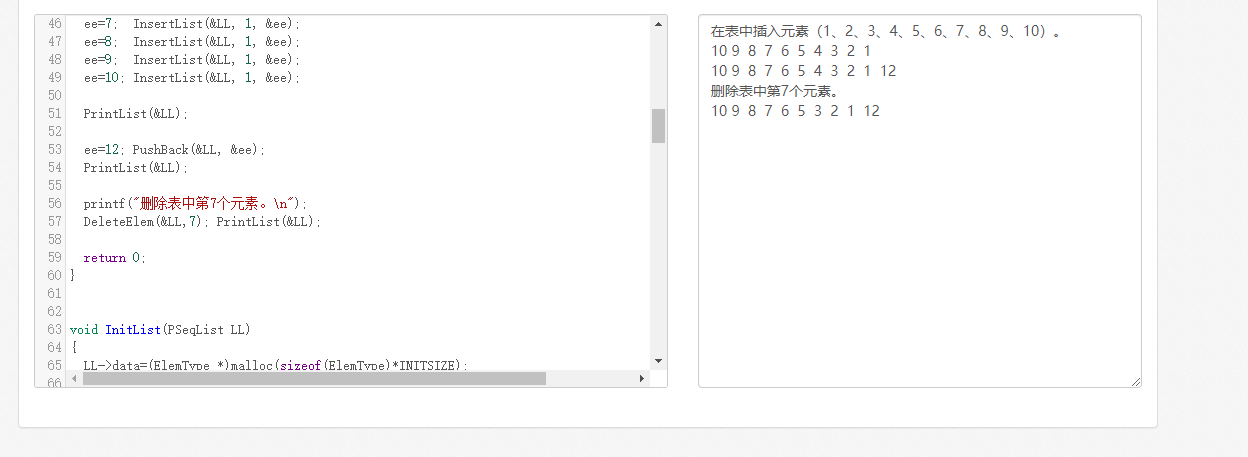
9、删除末尾元素
int PopBack(PSeqList LL);
int main()
{
SeqList LL; // 创建顺序表
ElemType ee; // 创建一个数据元素。
InitList(&LL); // 初始化顺序表。
printf("在表中插入元素(1、2、3、4、5、6、7、8、9、10)。\n");
ee=1; InsertList(&LL, 1, &ee);
ee=2; InsertList(&LL, 1, &ee);
ee=3; InsertList(&LL, 1, &ee);
ee=4; InsertList(&LL, 1, &ee);
ee=5; InsertList(&LL, 1, &ee);
ee=6; InsertList(&LL, 1, &ee);
ee=7; InsertList(&LL, 1, &ee);
ee=8; InsertList(&LL, 1, &ee);
ee=9; InsertList(&LL, 1, &ee);
ee=10; InsertList(&LL, 1, &ee);
PrintList(&LL);
ee=12; PushBack(&LL, &ee);
PrintList(&LL);
printf("删除表中第7个元素。\n");
DeleteElem(&LL,7); PrintList(&LL);
printf("删除表尾元素。\n");
PopBack(&LL); PrintList(&LL);
return 0;
}
// 删除顺序表LL中尾元素,返回值:0-位置ii不合法;1-成功。
int PopBack(PSeqList LL)
{
return DeleteElem(LL, LL->length);
}
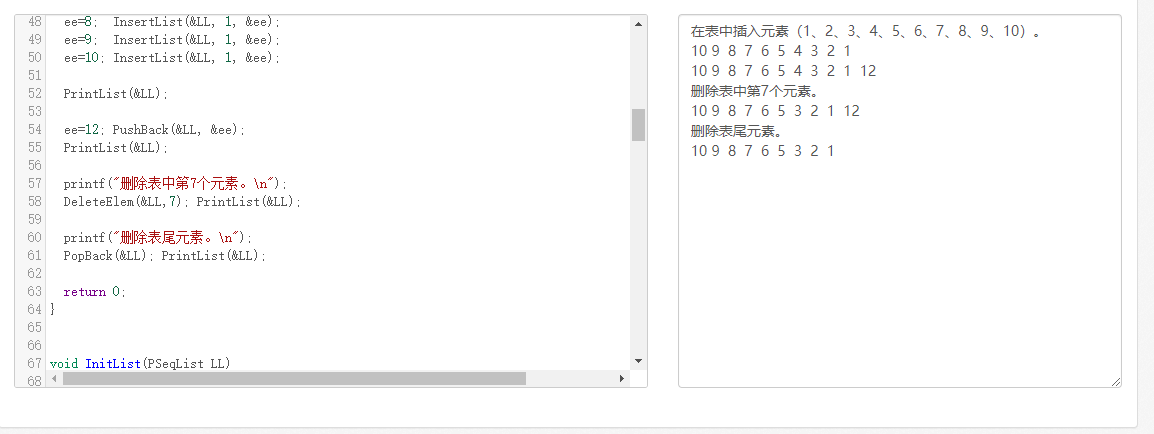
10、获取第n项的值
int GetElem(PSeqList LL, unsigned int ii, ElemType* ee);
int main()
{
SeqList LL; // 创建顺序表
ElemType ee; // 创建一个数据元素。
InitList(&LL); // 初始化顺序表。
printf("在表中插入元素(1、2、3、4、5、6、7、8、9、10)。\n");
ee=1; InsertList(&LL, 1, &ee);
ee=2; InsertList(&LL, 1, &ee);
ee=3; InsertList(&LL, 1, &ee);
ee=4; InsertList(&LL, 1, &ee);
ee=5; InsertList(&LL, 1, &ee);
ee=6; InsertList(&LL, 1, &ee);
ee=7; InsertList(&LL, 1, &ee);
ee=8; InsertList(&LL, 1, &ee);
ee=9; InsertList(&LL, 1, &ee);
ee=10; InsertList(&LL, 1, &ee);
PrintList(&LL);
ee=12; PushBack(&LL, &ee);
PrintList(&LL);
printf("删除表中第7个元素。\n");
DeleteElem(&LL,7); PrintList(&LL);
printf("删除表尾元素。\n");
PopBack(&LL); PrintList(&LL);
GetElem(&LL,3,&ee);
printf("第3个元素的值是%d。\n",ee);
return 0;
}
// 获取顺序表中第ii个元素的值,存放在ee中,返回值:0-失败;1-成功。
int GetElem(PSeqList LL, unsigned int ii, ElemType* ee)
{
if ( (LL == NULL) || (ee == NULL) ) return 0; // 检查空指针。
// 判断位置ii是否合法
if ( (ii < 1) || (ii > LL->length) ) return 0;
memcpy(ee,LL->data+ii-1,sizeof(ElemType)); // 采用memcpy是为了支持ee为结构体的情况。
return 0;
}
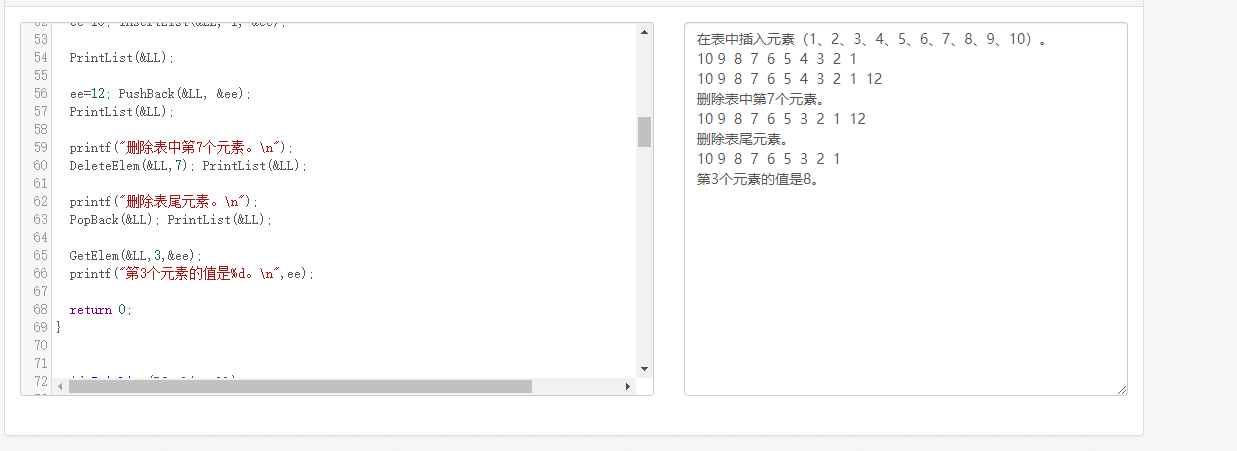
11、获取元素值所在的位置
int LocateElem(PSeqList LL, ElemType *ee);
int main()
{
SeqList LL; // 创建顺序表
ElemType ee; // 创建一个数据元素。
InitList(&LL); // 初始化顺序表。
printf("在表中插入元素(1、2、3、4、5、6、7、8、9、10)。\n");
ee=1; InsertList(&LL, 1, &ee);
ee=2; InsertList(&LL, 1, &ee);
ee=3; InsertList(&LL, 1, &ee);
ee=4; InsertList(&LL, 1, &ee);
ee=5; InsertList(&LL, 1, &ee);
ee=6; InsertList(&LL, 1, &ee);
ee=7; InsertList(&LL, 1, &ee);
ee=8; InsertList(&LL, 1, &ee);
ee=9; InsertList(&LL, 1, &ee);
ee=10; InsertList(&LL, 1, &ee);
PrintList(&LL);
ee=12; PushBack(&LL, &ee);
PrintList(&LL);
printf("删除表中第7个元素。\n");
DeleteElem(&LL,7); PrintList(&LL);
printf("删除表尾元素。\n");
PopBack(&LL); PrintList(&LL);
GetElem(&LL,3,&ee);
printf("第3个元素的值是%d。\n",ee);
ee=8;
printf("元素值为8的位置是=%d\n",LocateElem(&LL,&ee));
return 0;
}
// 查找ee在顺序表LL中的位置,返回值:0-元素ee在表LL中不存在,>0元素ee在表LL中的位置。
int LocateElem(PSeqList LL, ElemType *ee)
{
if (LL == NULL) return 0; // 检查空指针。
int kk;
for (kk = 0; kk < LL->length; kk++)
{
// 如果元素ee为结构体,这行代码要修改。
if (*(LL->data+kk) == *ee) return kk+1; // 在表中对应序号应为kk+1。
}
return 0;
}
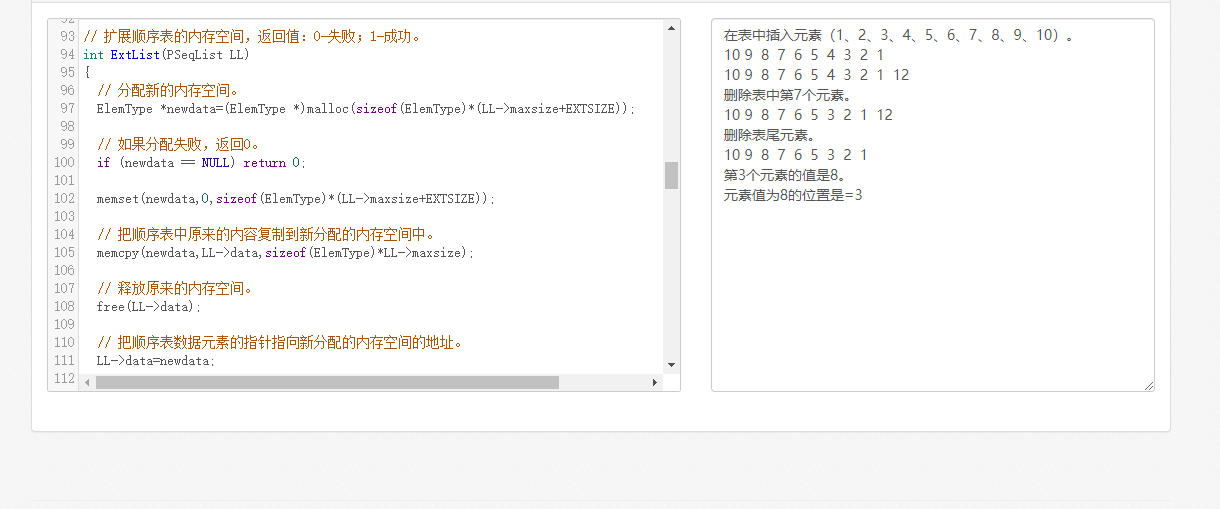
12、销毁顺序表
// 销毁顺序表LL。
void DestroyList(PSeqList LL);
int main()
{
SeqList LL; // 创建顺序表
ElemType ee; // 创建一个数据元素。
InitList(&LL); // 初始化顺序表。
printf("在表中插入元素(1、2、3、4、5、6、7、8、9、10)。\n");
ee=1; InsertList(&LL, 1, &ee);
ee=2; InsertList(&LL, 1, &ee);
ee=3; InsertList(&LL, 1, &ee);
ee=4; InsertList(&LL, 1, &ee);
ee=5; InsertList(&LL, 1, &ee);
ee=6; InsertList(&LL, 1, &ee);
ee=7; InsertList(&LL, 1, &ee);
ee=8; InsertList(&LL, 1, &ee);
ee=9; InsertList(&LL, 1, &ee);
ee=10; InsertList(&LL, 1, &ee);
PrintList(&LL);
ee=12; PushBack(&LL, &ee);
PrintList(&LL);
printf("删除表中第7个元素。\n");
DeleteElem(&LL,7); PrintList(&LL);
printf("删除表尾元素。\n");
PopBack(&LL); PrintList(&LL);
GetElem(&LL,3,&ee);
printf("第3个元素的值是%d。\n",ee);
ee=8;
printf("元素值为8的位置是=%d\n",LocateElem(&LL,&ee));
DestroyList(&LL); // 销毁顺序表LL。
return 0;
}
// 销毁顺序表LL。
void DestroyList(PSeqList LL)
{
free(LL->data);
LL->maxsize=0;
LL->length=0;
}
三、完整代码
/*
* 程序名:seqlist3.c,此程序演示顺序表的动态实现,数据元素是整数。
* 作者:C语言技术网(www.freecplus.net) 日期:20201230
*/
#include <stdio.h>
#include <string.h>
#include <stdlib.h>
#define INITSIZE 10 // 顺序表的初始长度。
#define EXTSIZE 5 // 每次扩展元素的个数。
typedef int ElemType; // 自定义顺序表的数据元素为整数。
typedef struct
{
ElemType *data; // 存储顺序表中元素的首地址。
unsigned int maxsize; // 顺序表元素的最大长度。
unsigned int length; // 顺序表中元素的个数。
}SeqList,*PSeqList;
// 顺序表LL的初始化操作。
void InitList(PSeqList LL);
// 销毁顺序表LL。
void DestroyList(PSeqList LL);
// 扩展顺序表的内存空间,返回值:0-失败;1-成功。
int ExtList(PSeqList LL);
// 在顺序表LL的第ii个位置插入元素ee,返回值:0-失败;1-成功。
int InsertList(PSeqList LL, unsigned int ii, ElemType *ee);
// 在顺序表LL的头结点插入元素ee,返回值:0-失败;1-成功。
int PushFront(PSeqList LL, ElemType *ee);
// 在顺序表LL的尾结点插入元素ee,返回值:0-失败;1-成功。
int PushBack(PSeqList LL, ElemType *ee);
// 求顺序表的长度,返回值:>=0-表LL元素的个数。
int LengthList(PSeqList LL);
// 获取顺序表中第ii个元素的值,存放在ee中,返回值:0-失败;1-成功。
int GetElem(PSeqList LL, unsigned int ii, ElemType* ee);
// 清空顺序表。
void ClearList(PSeqList LL);
// 判断顺序表是否为空,返回值:1-空,0-非空或失败。
int IsEmpty(PSeqList LL);
// 打印顺序表中全部的元素。
void PrintList(PSeqList LL);
// 查找ee在顺序表LL中的位置,返回值:0-元素ee在表LL中不存在,>0元素ee在表LL中的位置。
int LocateElem(PSeqList LL, ElemType *ee);
// 删除顺序表LL中的第ii个元素,返回值:0-位置ii不合法;1-成功。
int DeleteElem(PSeqList LL, unsigned int ii);
// 删除顺序表LL中头元素,返回值:0-位置ii不合法;1-成功。
int PopFront(PSeqList LL);
// 删除顺序表LL中尾元素,返回值:0-位置ii不合法;1-成功。
int PopBack(PSeqList LL);
int main()
{
SeqList LL; // 创建顺序表。
ElemType ee; // 创建一个数据元素。
InitList(&LL); // 初始化顺序表。
printf("在表中插入元素(1、2、3、4、5、6、7、8、9、10)。\n");
ee=1; InsertList(&LL, 1, &ee);
ee=2; InsertList(&LL, 1, &ee);
ee=3; InsertList(&LL, 1, &ee);
ee=4; InsertList(&LL, 1, &ee);
ee=5; InsertList(&LL, 1, &ee);
ee=6; InsertList(&LL, 1, &ee);
ee=7; InsertList(&LL, 1, &ee);
ee=8; InsertList(&LL, 1, &ee);
ee=9; InsertList(&LL, 1, &ee);
ee=10; InsertList(&LL, 1, &ee);
PrintList(&LL);
printf("在表头插入元素(11),表尾插入元素(12)。\n");
ee=11; PushFront(&LL, &ee);
ee=12; PushBack(&LL, &ee);
PrintList(&LL);
printf("在第5个位置插入元素(13)。\n");
ee=13; InsertList(&LL, 5, &ee);
PrintList(&LL);
printf("删除表中第7个元素。\n");
DeleteElem(&LL,7); PrintList(&LL);
printf("删除表头元素。\n");
PopFront(&LL); PrintList(&LL);
printf("删除表尾元素。\n");
PopBack(&LL); PrintList(&LL);
GetElem(&LL,3,&ee);
printf("第3个元素的值是%d。\n",ee);
ee=8;
printf("元素值为8的位置是=%d\n",LocateElem(&LL,&ee));
DestroyList(&LL); // 销毁顺序表LL。
return 0;
}
// 初始化顺序表
void InitList(PSeqList LL)
{
LL->data=(ElemType *)malloc(sizeof(ElemType)*INITSIZE);
LL->maxsize=INITSIZE;
ClearList(LL); // 清空顺序表。
}
// 清空顺序表。
void ClearList(PSeqList LL)
{
if (LL == NULL) return; // 检查空指针。
LL->length=0;
memset(LL->data,0,sizeof(ElemType)*LL->maxsize);
}
// 销毁顺序表LL。
void DestroyList(PSeqList LL)
{
free(LL->data);
LL->maxsize=0;
LL->length=0;
}
// 求顺序表的长度,返回值:>=0-表LL元素的个数。
int LengthList(PSeqList LL)
{
if (LL == NULL) return 0; // 检查空指针。
return LL->length;
}
// 获取顺序表中第ii个元素的值,存放在ee中,返回值:0-失败;1-成功。
int GetElem(PSeqList LL, unsigned int ii, ElemType* ee)
{
if ( (LL == NULL) || (ee == NULL) ) return 0; // 检查空指针。
// 判断位置ii是否合法
if ( (ii < 1) || (ii > LL->length) ) return 0;
memcpy(ee,LL->data+ii-1,sizeof(ElemType)); // 采用memcpy是为了支持ee为结构体的情况。
return ;
}
// 扩展顺序表的内存空间,返回值:0-失败;1-成功。
int ExtList(PSeqList LL)
{
// 分配新的内存空间。
ElemType *newdata=(ElemType *)malloc(sizeof(ElemType)*(LL->maxsize+EXTSIZE));
// 如果分配失败,返回0。
if (newdata == NULL) return 0;
memset(newdata,0,sizeof(ElemType)*(LL->maxsize+EXTSIZE));
// 把顺序表中原来的内容复制到新分配的内存空间中。
memcpy(newdata,LL->data,sizeof(ElemType)*LL->maxsize);
// 释放原来的内存空间。
free(LL->data);
// 把顺序表数据元素的指针指向新分配的内存空间的地址。
LL->data=newdata;
// 重置顺序表的maxsize变量。
LL->maxsize=LL->maxsize+EXTSIZE;
return 1;
}
// 在顺序表LL的第ii个位置插入元素ee,返回值:0-失败;1-成功。
int InsertList(PSeqList LL, unsigned int ii, ElemType *ee)
{
if ( (LL == NULL) || (ee == NULL) ) return 0; // 检查空指针。
if (LL->length >= LL->maxsize)
{
if (ExtList(LL) == 0) { printf("护展顺序表失败。\n"); return 0; }
}
// 判断插入位置是否合法
if ( (ii < 1) || (ii > LL->length+1) )
{
printf("插入位置(%d)不合法,应该在(%d-%d)之间。\n",ii,1,LL->length+1); return 0;
}
// 注意,元素后移只能用循环,不能用以下注释掉的方法,当元素是结构体时,以下方法不稳定。
// if ( ii < LL->length+1)
// memcpy(LL->data+ii,LL->data+ii-1,(LL->length-ii+1)*sizeof(ElemType));
// 把ii和ii之后的元素后移。
int kk;
for (kk=LL->length;kk>=ii;kk--)
{
memcpy(LL->data+kk,LL->data+kk-1,sizeof(ElemType)); // 采用memcpy是为了支持ee为结构体的情况。
// memcpy(&LL->data[kk],&LL->data[kk-1],sizeof(ElemType)); // 也可以采用数组的形式。
}
memcpy(LL->data+ii-1,ee,sizeof(ElemType)); // 采用memcpy是为了支持ee为结构体的情况。
LL->length++; // 表的长度加1。
return 1;
}
// 在顺序表LL的头结点插入元素ee,返回值:0-失败;1-成功。
int PushFront(PSeqList LL, ElemType *ee)
{
return InsertList(LL,1,ee);
}
// 在顺序表LL的尾结点插入元素ee,返回值:0-失败;1-成功。
int PushBack(PSeqList LL, ElemType *ee)
{
return InsertList(LL,LL->length+1,ee);
}
// 删除顺序表LL中的第ii个元素,返回值:0-位置ii不合法;1-成功。
int DeleteElem(PSeqList LL, unsigned int ii)
{
if (LL == NULL) return 0; // 检查空指针。
// 判断删除位置ii是否合法
if ( (ii < 1) || (ii > LL->length) )
{
printf("删除位置(%d)不合法,应该在(%d-%d)之间\n",ii,1,LL->length); return 0;
}
// 把ii之后的元素前移。
int kk;
for (kk=ii;kk<=LL->length;kk++)
{
memcpy(LL->data+kk-1,LL->data+kk,sizeof(ElemType)); // 采用memcpy是为了支持ee为结构体的情况。
}
LL->length--; // 表的长度减1。
return 1;
}
// 查找ee在顺序表LL中的位置,返回值:0-元素ee在表LL中不存在,>0元素ee在表LL中的位置。
int LocateElem(PSeqList LL, ElemType *ee)
{
if (LL == NULL) return 0; // 检查空指针。
int kk;
for (kk = 0; kk < LL->length; kk++)
{
// 如果元素ee为结构体,这行代码要修改。
if (*(LL->data+kk) == *ee) return kk+1; // 在表中对应序号应为kk+1。
}
return 0;
}
// 删除顺序表LL中头元素,返回值:0-位置ii不合法;1-成功。
int PopFront(PSeqList LL)
{
return DeleteElem(LL, 1);
}
// 删除顺序表LL中尾元素,返回值:0-位置ii不合法;1-成功。
int PopBack(PSeqList LL)
{
return DeleteElem(LL, LL->length);
}
// 判断顺序表是否为空,返回值:1-空,0-非空或失败。
int IsEmpty(PSeqList LL)
{
if (LL == NULL) return 0; // 检查空指针。
if (LL->length == 0) return 1;
return 0;
}
// 打印顺序表中全部的元素。
void PrintList(PSeqList LL)
{
if (LL == NULL) return; // 检查空指针。
if (LL->length == 0) { printf("表为空。\n"); return; }
int kk;
for (kk = 0; kk < LL->length; kk++)
{
printf("%-3d", *(LL->data+kk)); // 如果元素ee为结构体,这行代码要修改。
}
printf("\n");
}

